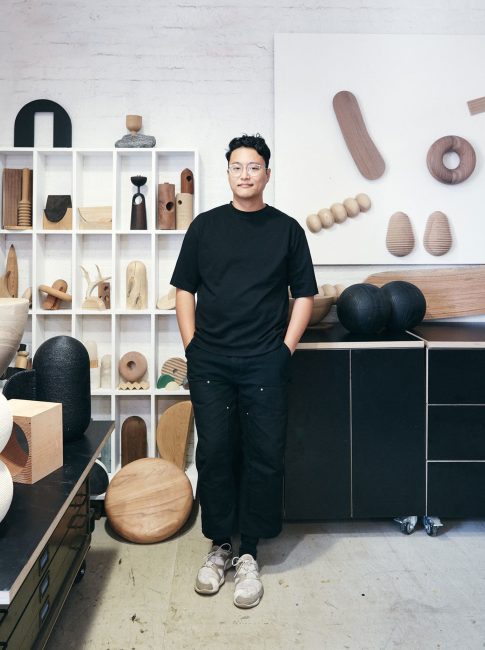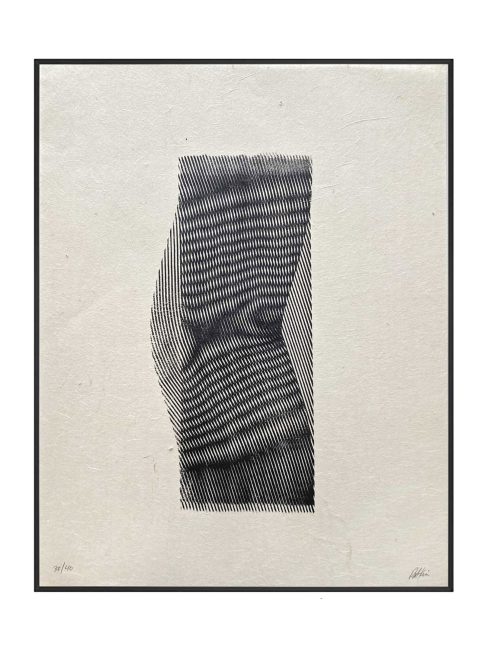Pat Kim x Hanji Edition
Hanji Edition is pleased to announce a limited edition print collaboration with Pat Kim, a New York-based designer/artist working primarily in objects, furniture, and sculpture. For this print, Pat created a hand-turned woodblock which he used to print moiré patterns onto Korean mulberry paper (hanji) made by Steph Rue in California. Each print is a one-of-a-kind impression and comes hand-numbered and signed by the artist.
Pat’s approach is defined by constant experimentation in materials and methods gleaned from traditional craft. His work is rooted in the philosophy of sculptural simplicity and enduring quality. He seeks to create timeless, thoughtful, genial objects and bring them to the world.
Pat Kim x Hanji Edition
2023
Ink on hanji
11″ x 14”
Edition size: 40
This edition is now sold out. Thank you to everyone for their support!


Interview with Pat Kim
Artist Name: Pat Kim
Location: New York, NY
Website + social media: patkimdesign.com, @patkimpatkim
You are a talented artist-designer who works in objects, furniture and sculpture. What led you to pursue this creative path? How and when did you also begin printing?
I’ve always been interested in how things work, I loved taking things apart at home when I was young. This eventually led me to study industrial design in college, but I became more interested in working with my hands after school. I worked for a furniture maker for a while until I felt confident enough to start my own studio practice. For years I was focused on wood turning, scaling up my work from little precious things to sculptural furniture pieces. I started to dabble in wood block printing, mostly for gifts for friends, using interesting offcuts and scraps I had laying around. The moire prints came about serendipitously, a result of a shelved wood turning with an experimental texture treatment I decided to ink up and roll.
How would you describe your creative process?
My process centers around experimentation, with materials and processes. I horde materials, mostly natural like wood, stone, leather and shell, and I’m a fiend for interesting little hand tools. The availability of these things lets me tinker and I try to dedicate a little time each day to making something new. I live with my experiments and draw inspiration from them or revisit them from time to time.
Please describe how you made the printing blocks for your moiré prints.
Like so much of my work, the tools for making the moire prints are a product of the lathe. Using a special tool to carve the texture on the surface of turned wood or resins, I can make rollers of various sizes and pitches.
What [other] materials and tools did you employ for the prints?
Printing on hanji presented a couple new challenges that I had to problem solve, which I didn’t mind at all since I love making jigs and tools. Since the hanji is so thin and fine, I had trouble keeping the paper down flat while rolling. I was advised to use a vacuum table and I made one specifically to use with the hanji for this edition. It took some finessing, I had to try different methods for generating vacuum pressure, various ways to seal the paper to the table, and what substrates to use that allowed me to get the right impression with my roller.
How familiar with hanji were you prior to this project?
I’ve been curious about paper making for a while, it’s such a fascinating process. I enjoy watching videos of papermaking, especially the harvesting and processing of the raw materials as well as the tools involved. I’d love to try my hand at making it myself.
What were your impressions of working with hanji, from early tests on different kinds of hanji to trying out various printing techniques? Did you alter your normal printing process in any way?
I was surprised at how thin yet strong the paper was. I experimented with tearing the paper to size and it was so pleasantly resilient. I was worried at first that the texture would interfere with making a clean impression, but it takes ink so nicely. Aside from using a vacuum table, I didn’t have to alter my process drastically.
Anything else you would like to share about your experience working on this project?
It was such a joy to work with such beautifully hand made material. I loved variation in texture and color, the way you could tell it was made from a natural material. It was immediately apparent how much care went into every sheet and how unique each sheet was.